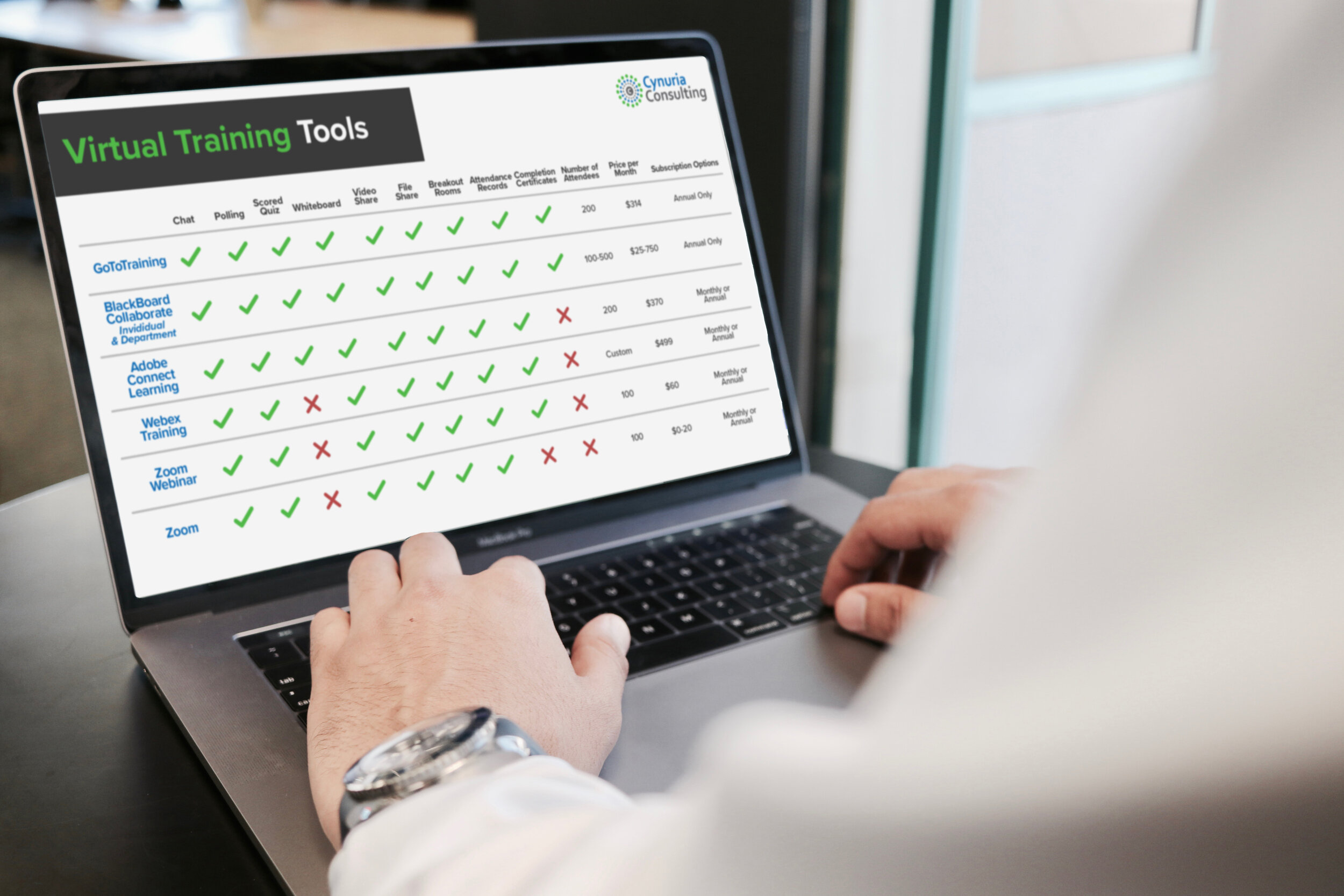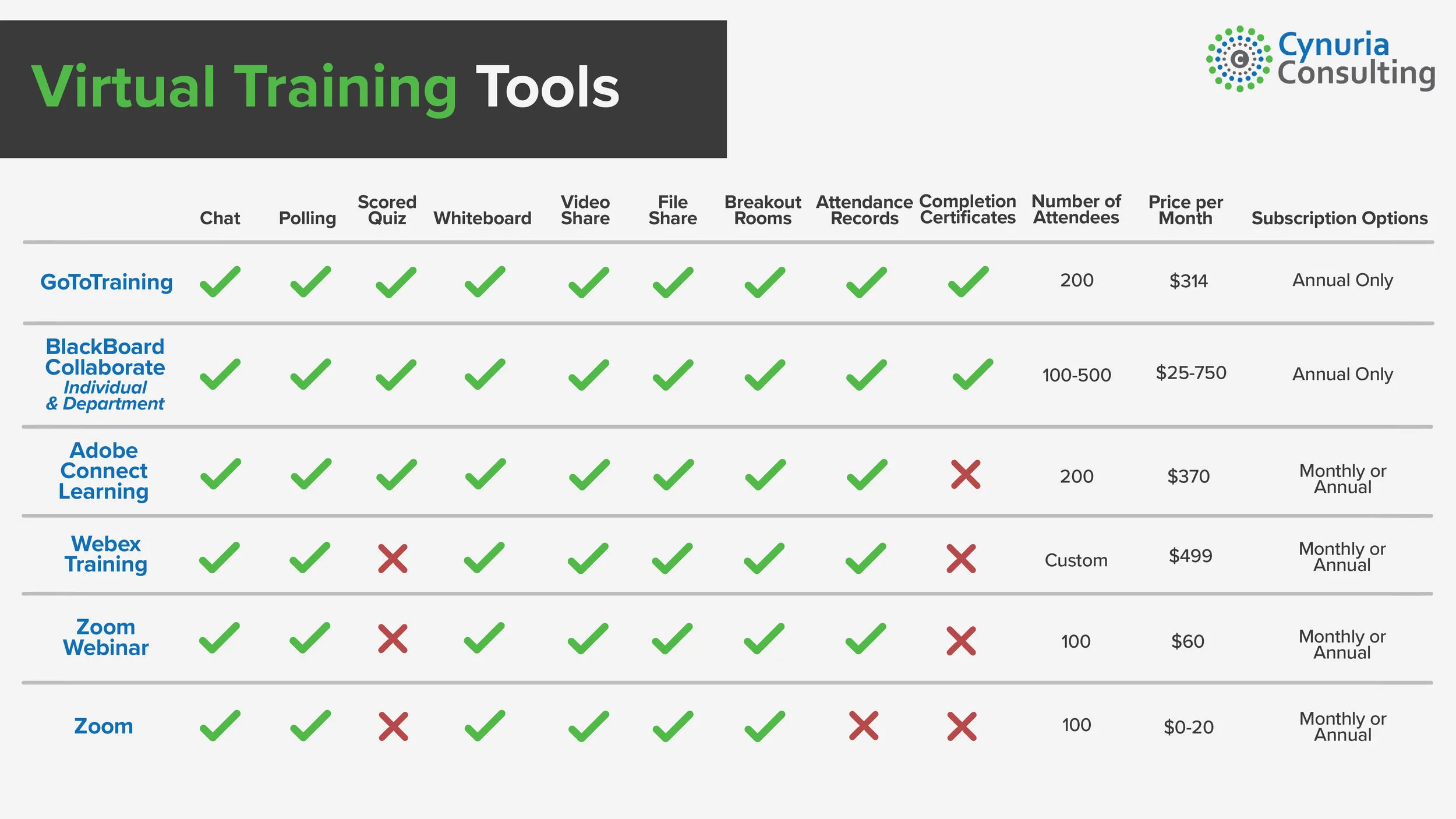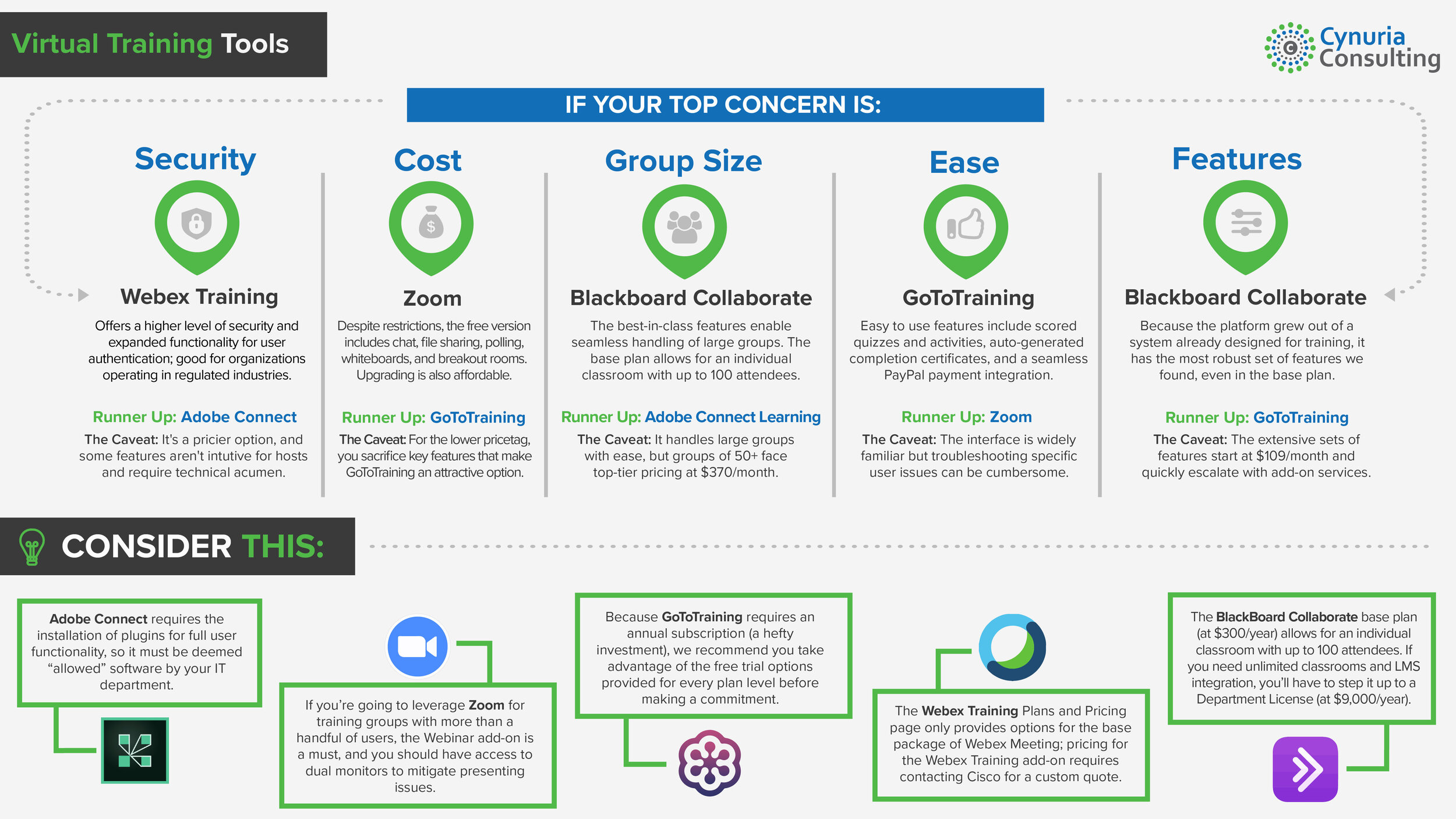The Best Virtual Tools For Teaching & Training
You may have discovered by now, that the tools needed for effective virtual training facilitation are not available as a one-size-fits-all collection of features and functionality. Deciding on the right tool often depends on how the training is deployed, the desired level of interaction, budgetary restrictions, and reporting requirements.
So, which platforms really fit the bill when it comes to leveraging virtual tools for training?
We looked at the most widely used online tools and reviewed them based on the features and functionality most often relied upon for virtual training. For the purpose of this review, we’ve delineated the differences between the core features of traditional systems and their enhanced, training-specific products.
Finding the Right Tool
To find the right virtual training tool for you or your organization, start by looking at the basic features and functionality of different platforms. Some common tools like chat boxes, polling, raise hand features, and file sharing are available as part of virtually every mainstream virtual training tool. But more advanced features including whiteboards, breakout rooms, scored assessments, attendance records, and completion certificates are usually not available without potentially pricey add-ons.
The below review of virtual training tools identifies what’s included in the base package, the subscription price and terms, and covers additional features and considerations for virtual training purposes.
Adobe Connect Learning
$370/monthly, monthly or annual subscriptions available
Adobe Connect is one of the most robust online virtual training systems available in terms of bandwidth, storage, and performance for larger groups of users. Additionally, content like PowerPoint presentations and video assets can be preloaded, significantly boosting performance and improving user experience if you’re going to be leveraging larger files within your session.
The base package, Adobe Connect Meetings, includes chat, file sharing, polling, whiteboards, and breakout rooms, but to access additional features such as scored activities and attendance records, you’ll need to spring for the full Adobe Connect Learning tool.
It’s also worthwhile to note that from a technical perspective, Adobe Connect Learning does require the installation of plugins for full user functionality, so it must be deemed “allowed” software by your IT department.
Zoom & Zoom Webinar
$0-$60+/month, monthly or annual subscriptions available
The use of Zoom has risen exponentially in recent months, primarily due to the free base plan option. Significant restrictions exist in leveraging the free option for training though, as the number of attendees is limited and sessions are capped at 40 minutes. On the plus side, the paid plan is still very affordable, and both options include chat, file sharing, polling, whiteboards, and breakout rooms. For additional features related to attendance tracking, branding, and user management controls, Zoom provides a Webinar add-on starting at$40/month on top of your normal subscription (webinar add-on pricing varies based on the number of webinar attendees).
Most likely due to its popularity and volume of users, performance is significantly hindered in larger sessions (>30 users) and delays in audio and frequent video “freeze-ups” can be expected. This is because Zoom does not use a dedicated bandwidth model.
Sharing PowerPoint presentations and video assets is also not seamless on Zoom; bugs may prevent you from viewing a PowerPoint presentation in Presenter Mode while displaying the full slides for your attendees, depending on what operating system you’re using. Also, Zoom does not allow you to preload assets, so you’ll be at the mercy of your connection speed—and so will your attendees.
If you’re going to leverage Zoom for training groups with more than a handful of users, the Webinar add-on is a must, and you should have access to dual monitors to mitigate any presenting issues (although we still recommend thorough testing).
GoToTraining
$314/month, requires an annual subscription
While you may already be using GoToMeeting for virtual meetings and presentations, you’ll need a subscription for a GoToTraining plan (Starter, Pro, and Plus) to take advantage of advanced features like whiteboards, breakout rooms, and attendance records.
While it is somewhat pricey, GoToTraining Plus has one of the most extensive sets of features we found, including some additional hard-to-find options like scored quizzes and activities, and auto-generated completion certificates. If your attendees are paying for the session, all the GoToTraining plans are integrated with PayPal as an added benefits feature.
Because an annual subscription is required and means making a hefty investment, we recommend you take advantage of the free trial option before making a commitment.
Webex Training
$499+/month, monthly or annual subscriptions available
Webex Meeting is a familiar tool in the virtual training space and includes chat, file sharing, polling, and whiteboards. To access more advanced features, however, such as breakout rooms and attendance records, you need to expand your subscription to include Webex Training, which also includes a built-in (optional) eCommerce feature if you charge for your sessions.
Since Webex as a platform has been around for a while, you can count on reliable performance and a decent set of features. It also offers a higher level of security and expanded functionality for user authentication, which may make it an attractive option for organizations operating in regulated industries. One point of frustration, however, is the unclear pricing model; the Plans and Pricing page only provides options for the base package of Webex Meeting, which means pricing for the Webex Training add-on requires contacting Cisco for a custom quote.
Blackboard Collaborate
$25-$750/month, requires an annual subscription
Blackboard Collaborate is relatively new to the conferencing space, although Blackboard itself is familiar to many due to its longevity as an LMS widely used by educational institutions. Because the Blackboard Collaborate platform grew out of a system already designed for training, it has the most robust set of features we found, even in the base plan. It includes chat, file sharing, polling, whiteboards, breakout rooms, scored activities, attendance, and more. It truly is designed as a virtual classroom, incorporating features that will appeal to business subscribers who may not normally seek out a “classroom” solution for conferencing.
The Blackboard Collaborate pricing model is based on the number of instructors or classrooms you need and whether you want to integrate it with an LMS. All plans require an annual commitment, so we recommend taking advantage of the 30-day free trial before subscribing. The base plan (at $300/year) allows for an individual classroom with up to 100 attendees. If you need unlimited classrooms and LMS integration, you’ll have to step it up to a Department License (at $9,000/year). Unfortunately, there are currently no plan options between these two price points, although they do offer custom pricing for enterprise accounts.
Selecting the Best Option
Identifying and selecting the best training tool for you and your organization depends on your budget and how you plan to leverage it. If your needs are simple, you can likely opt for a less expensive option and stick with basic functionality. Shiny new bells and whistles are great, but remember that user experience is primarily based on ease of use and performance. And, if your goal is to provide a meaningful learning experience for participants, keep in mind that the quality of your content is just as important as the technology with which it is deployed.
Cynuria Consulting is passionate about helping organizations cultivate a culture of learning and development. We’re here to partner with you in developing a winning strategy for growth. Contact us at info@cynuriaconsulting.com today to learn more.




